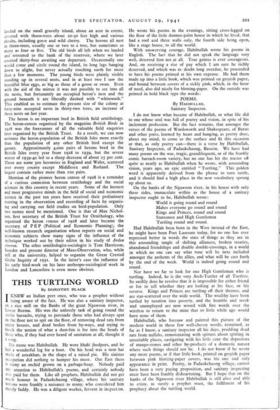COUNTING HERONS
By R. S. R. FITTER
ST. JAMES'S STREET, Walthamstow, does not at sight look the right starting-point for a bird-watch expedition—words that conjure up visions of the flat t haunted sand-hills of Scolt Head, the precipitous cliff-ha of choughs in West Wales, the wide Solway marshes their grey and barnacle geese. The rendezvous, however, in fact St. James's Street Station, and the ultimate desti' tion the Metropolitan Water Board's Walthamstow Reserve Our business was the annual census of the heronry behalf of the British Trust for Ornithology and London Natural History Society. The heronry at Walt stow is the nearest heronry to London, and is situ on one of the two small islands in No. 5 reservoir. It apparently colonised originally from the ancient heronry Wanstead Park a few miles away, nesting being first reco at Waltharnstow by Mr. H. F. Witherby in 1914. In 19 there were 6o nests at Wanstead and five at Walthamstow, by 194o practically the whole population of Wanstead migrated to Walthamstow where there were some 46 occu nests, leaving only five at Wanstead.
As we came along Coppermill Lane, which runs bets No. 5 and Racecourse reservoirs, we could see the Fr grey of the herons standing on their nests in the pale g thorn-trees. A sedge-warbler greeted us with a burst of harsh, loud song, and a resplendent cock reed-bunting um its staccato notes nearby. Little pied tufted drakes dotted waters of the reservoirs with their duller mates,- and sere pairs of mallard and great crested grebes.
The voyage out to the island proved quite exciting, tho not, I fear, in the best traditions of the British Navy. conjunction of a strong easterly wind, whipping up size waves on the reservoir, with a marked lack of navigational on our part led to most of the outward voyage taking the f of towing the boat along the side of the reservoir till reached the nearest point to the heronry. Here we halted affix to a long pole a mirror that would enable us to see the nests from below. While this, and incidentally lunch, taking place, a superb exhibition of aerobatics was on vi One of the three kestrels which had been playing about in air suddenly made a magnificent shallow dive of nearly quarter of a mile, equal to anything I have ever seen from peregrine. From about 150-zoo feet up it dived straight .
the tallest tree on the other island. As it alighted, a marau crow beat a hasty retreat from the kestrel's nest.
The actual voyage was quickly accomplished, and we . landed on the small gravelly island, about an acre in extent, covered with thorn-trees about 20-30 feet high and various shrubs, including gorse and wild cherry. The herons all nest in thorn-trees, usually one or two to a tree, but sometimes as many as four or five. The old birds all left when we landed and retreated to the bank of the reservoir, where we later counted thirty-four awaiting our departure. Occasionally one would come and circle round the island, its long legs hanging down to alight, but never actually touching earth for more than a few moments. The young birds were plainly visible standing up in several nests, and in at least two I saw the beautiful blue eggs, as big as those of a goose or swan. Even with the aid of the mirror it was not possible to see into all the nests, but fortunately an occupied heron's nest and the ground beneath it are liberally daubed with " whitewash." This enabled us to estimate the present size of the colony at forty-nine occupied nests in thirty-two trees, an increase of three nests on last year.
The heron is an important bird in British field ornithology. The heron-census organised by the magazine British Birds in 1928 was the forerunner of all the valuable field enquiries later organised by the British Trust. As a result, we can now estimate the heron-population of the British Isles more exactly than the population of any other British bird except the gannet. Approximately 4,000 pairs of herons bred in the British Isles every year from 1928 to 1939, but the severe winter of 1939-40 led to a sharp decrease of about 25 per cent. There are some 300 heronries in England and Wales, scattered over every county except Middlesex and Rutland. The largest contain rather more than roc) pairs..
Mention of the pioneer heron census of 1928 is a reminder of a curious connexion between ornithology and the social sciences in this country in recent years. Some of the keenest and most progressive minds in the field of social and economic science in the past ten years have received their preliminary training in the observation and recording of facts by organis- ing and carrying out field studies on bird-population. Only two names need be mentioned. One is that of Max Nichol- son, first secretary of the British Trust for Ornithology, who organised the heron census of 1928 and later became the secretary, of P E P (Political and Economic Planning), the well-known research organisation whose reports on social and economic subjects show many signs of the influence of the technique worked out by their editor in his study of Ardea cinerea. The other ornithologist-sociologist is Tom Harrisson, founder and present director of Mass-Observation, who, while still at the university, helped to organise the Great Crested Grebe Inquiry of 1931. In the latter's case the influence of his early bird-work on his later anthropo-sociological work in London and Lancashire is even more obvious.



































 Previous page
Previous page